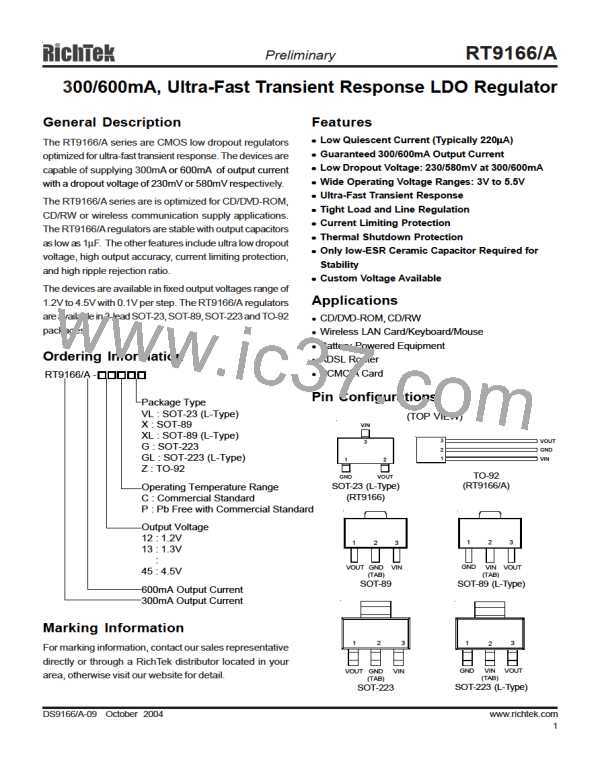Preliminary
RT9166/A
Application Information
No Load Stability
Like any low-dropout regulator, the RT9166/A series
requires input and output decoupling capacitors. These
capacitors must be correctly selected for good
performance (see Capacitor Characteristics Section).
Please note that linear regulators with a low dropout
voltage have high internal loop gains which require care
in guarding against oscillation caused by insufficient
decoupling capacitance.
The device will remain stable and in regulation with no
external load. This is specially important in CMOS RAM
keep-alive applications.
Input-Output (Dropout) Voltage
A regulator's minimum input-to-output voltage differential
(dropout voltage) determines the lowest usable supply
voltage. In battery-powered systems, this determines the
useful end-of-life battery voltage. Because the device uses
a PMOS, its dropout voltage is a function of drain-to-
source on-resistance, RDS(ON), multiplied by the load
current:
Input Capacitor
An input capacitance of ≅ 1µF is required between the
device input pin and ground directly (the amount of the
capacitance may be increased without limit). The input
capacitor MUST be located less than 1 cm from the device
to assure input stability (see PCB Layout Section).Alower
ESR capacitor allows the use of less capacitance, while
higher ESR type (like aluminum electrolytic) require more
capacitance.
VDROPOUT = VIN - VOUT = RDS(ON) x IOUT
Current Limit
The RT9166/A monitors and controls the PMOS' gate
voltage, minimum limiting the output current to 300mA for
RT9166 and 600mA for RT9166A. The output can be
shorted to ground for an indefinite period of time without
damaging the part.
Capacitor types (aluminum, ceramic and tantalum) can
be mixed in parallel, but the total equivalent input
capacitance/ESR must be defined as above to stable
operation.
Short-Circuit Protection
There are no requirements for the ESR on the input
capacitor, but tolerance and temperature coefficient must
be considered when selecting the capacitor to ensure the
capacitance will be ≅ 1µF over the entire operating
temperature range.
The device is short circuit protected and in the event of a
peak over-current condition, the short-circuit control loop
will rapidly drive the output PMOS pass element off. Once
the power pass element shuts down, the control loop will
rapidly cycle the output on and off until the average power
dissipation causes the thermal shutdown circuit to
respond to servo the on/off cycling to a lower frequency.
Please refer to the section on thermal information for
power dissipation calculations.
Output Capacitor
The RT9166/A is designed specifically to work with very
small ceramic output capacitors. The recommended
minimum capacitance (temperature characteristics X7R
or X5R) is 1µF to 4.7µF range with 10mΩ to 50mΩ range
ceramic capacitor between LDO output and GND for
transient stability, but it may be increased without limit.
Higher capacitance values help to improve transient. The
output capacitor's ESR is critical because it forms a zero
to provide phase lead which is required for loop stability.
(When using the Y5V dielectric, the minimum value of
the input/output capacitance that can be used for stable
over full operating temperature range is 3.3µF.)
Capacitor Characteristics
It is important to note that capacitance tolerance and
variation with temperature must be taken into
consideration when selecting a capacitor so that the
minimum required amount of capacitance is provided over
the full operating temperature range. In general, a good
tantalum capacitor will show very little capacitance
variation with temperature, but a ceramic may not be as
good (depending on dielectric type).
www.richtek.com
8
DS9166/A-09 October 2004

 ETC [ ETC ]
ETC [ ETC ]